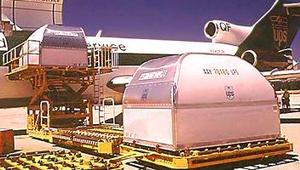Analysis // Cargo securityExperts: cargo bombs raise questions about adequacy of technology
The PETN bombs found onboard cargo aircraft at East Midlands airport and Dubai airport were hidden inside computer printers; the deadly devices were not picked up by X-ray screening or sniffer dogs; intelligence will continue to play a major role in maintaining air security as even advanced screening technologies are not perfect and checking every piece of cargo would be impractical

Airfreight is placed in canisters for faster on- and off-loading // Source: parkingspa.com
The bombs found on board two U.S.-bound cargo aircraft this weekend demonstrate that current freight-screening technology still cannot guarantee air security, according to experts.
As the government’s emergency planning committee COBRA (for cabinet office briefing room meeting) meets today to discuss tougher airport security measures, explosive detection experts have told the Engineer there will continue to be dangerous gaps in security without the development of more advanced screening technology.
Siobhan Wagner writes that pentaerythritol tetranitrate, or PETN, the type of explosive material used in the bombs found onboard cargo aircraft at East Midlands airport and Dubai airport, were hidden inside computer printers. The deadly devices were not picked up by X-ray screening or sniffer dogs.
Don Arnone, chief executive of Cambridge-based TeraView, said this shows the “deficiency” of current cargo checks, which are done in bulk.
While PETN went unnoticed by X-ray screening, Arnone said it could have been spotted using advanced security detection techniques such as ion mobility spectroscopy (IMS).
An IMS mass spectrometer works by sucking in air samples and differentiating ionized molecules by their mobility in the gas phase. If an air sample was taken from cargo, he said, it could help analysts determine whether an explosive substance was present.
Arnone stressed it would be challenging to attain measurements from large cargo because samples would need to be captured from multiple points. A cargo container the size of a small room, he said, could take up to twenty minutes to measure.
In order to reduce the chance of false positives, Arnone added, IMS could be used with at least one other detection technique.
Three months ago we reported on a TeraView scanning technology under development for passenger screening at airports (“New explosives detection technologies show promise,” 3 August 2010 HSNW). The company’s technology uses Terahertz light to detect different types of plastic explosives through clothing, including PETN, the explosive that a foiled bomber successfully carried onto a U.S. airliner flying from Amsterdam to Detroit last December.
Arnone said this technology could also be developed for cargo screening.
Wagner notes that the bombs at East Midlands airport and Dubai airport were discovered following a tip-off by an informant to Saudi Arabian intelligence. According to reports, a special team of officers from MI5, MI6, and GCHQ was activated as soon as Saudi Arabian authorities tipped off U.S. and U.K. intelligence agencies.
Arnone said intelligence will play a major role in maintaining air security as even advanced screening technologies are not perfect and checking every piece of cargo would be impractical.
“It’s obviously not foolproof but if you combine that with intelligence on where the shipment came from, the origin of the shipment and where it’s going, the agencies can make some intelligent decisions about what they spend time checking thoroughly,” he said.
“There is a fundamental issue at the moment that until that technology exists there will be gaps in security. So there’s no silver bullet here to solve the problem now, there may be in the future, but at the moment governments can only use the technology that they have to deploy and do it in a slightly more intelligent and slightly more thorough manner than they’re doing.”
